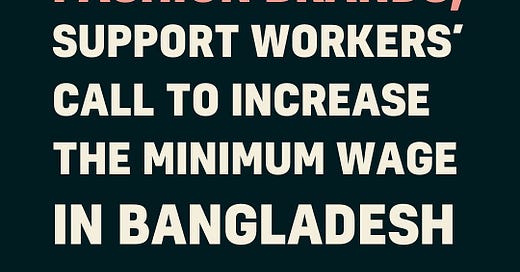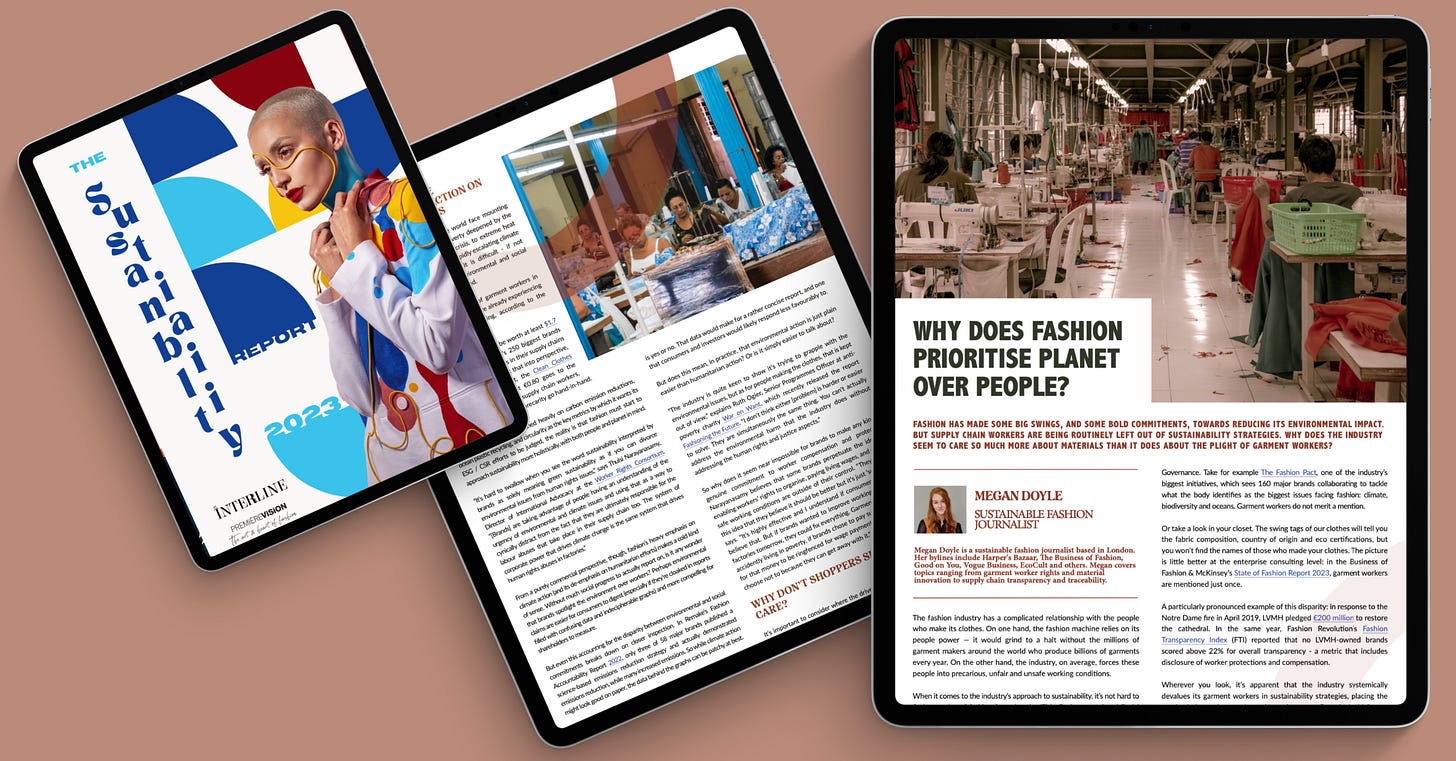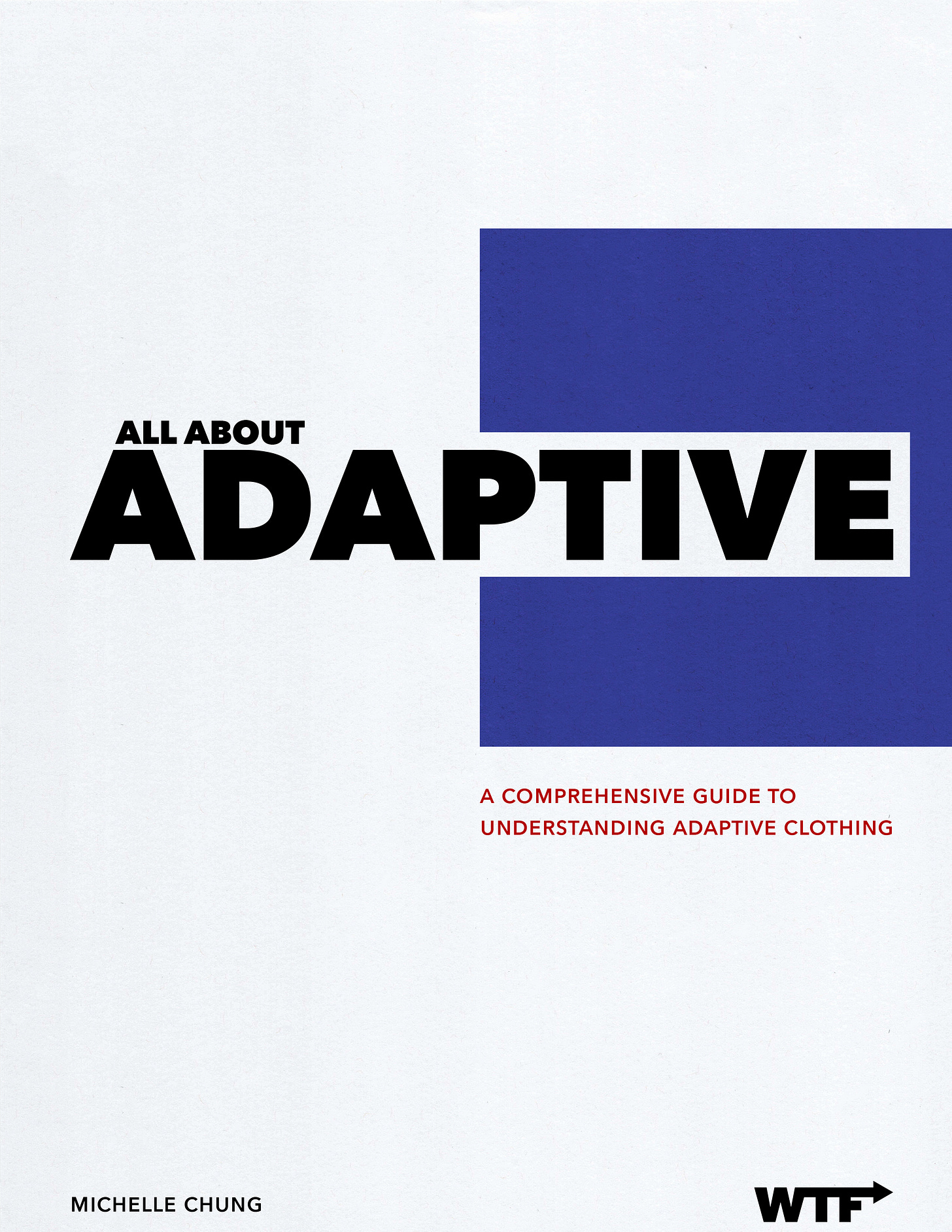October in Fashion, Condensed.
An interview with adaptive fashion consultant Michelle Chung, the modelling agencies recruiting from refugee camps, why fibre fraud is rife, and fast fashion shouldn't be a sustainability scapegoat.
Hello there,
It’s a huge day for garment workers in Bangladesh. For the last week, they have been protesting in the streets of Dhaka, Ashulia and Gazipur to demand a long-awaited minimum wage increase. Today, the country’s Minimum Wage Board will conduct the first minimum wage review in five years.
Protests have escalated over the last few months, as garment workers (of which there are around 4.5 million in Bangladesh) seek to raise the monthly minimum wage from BDT 8,000 (£58 or US$72) to BDT 23,000 (£167 or US$209). Even this is below the country’s living wage of BDT 25,500.
Bangladesh is home to around 3,500 garment factories that supply major brands all around the world. The country relies on its garment sector — apparel makes up 84% of exports — but calls for higher wages have repeatedly fallen on deaf ears.
The current wage of BDT 8,000/month is woefully inadequate, with the increase in cost of living, inflation and the aftermath of the pandemic making life increasingly difficult for Bangladeshi workers. That’s not to mention the inherently fragile nature of garment work, which is vulnerable to the whims of foreign brands, who have a reputation for cancelling orders and refusing to pay their suppliers.
In October, 15 companies, including GAP, Lululemon and Adidas wrote an open letter to Bangladeshi Prime Minister Sheikh Hasina in support of the wage increase, but very few have committed to playing their part in solving the wage crisis. According to Fashion Revolution’s Fashion Transparency Index, 99% of brands don’t disclose the number of workers in their supply chains being paid living wages. (Spoiler: there’s not much to disclose.)
“Words are easy but the actual reality of paying a living wage and not moving orders to source from the cheapest place is the only proof that brands actually care about their workers,” Dominique Muller, policy director at Labour Behind the Label told Sourcing Journal. “Adidas’s operating profit for the quarter to August ’23 was around €176 million ($187.7 million) and yet it hesitates to support workers’ basic needs.”
The fashion industry has become rather fond of making sustainability commitments in recent years but has by and large ignored garment workers. These protests are a result of decades of systemic issues that have reached a tipping point. Tragically, two protestors have been killed in the protests this week.
This month, my long-read for the Interline (below) dives into why the fashion industry focuses on environmental impact, from carbon footprint to ocean waste plastics, but consistently refuses to address, support or adequately pay the people who make our clothes. It’s certainly not an accident that they aren’t paid enough to feed themselves or support their families — this is how the fashion system was designed.
The experts I spoke to believe that brands could establish living wages in their supply chains tomorrow if they wanted to, but anything that cuts into profits is often deemed ‘too difficult’. And so the fate of millions of Bangladeshi garment workers hangs in the balance. You can learn more about the situation from labour activist Kalpona Akter here.
As ever, I love to hear your thoughts and burning sustainable fashion questions. Hit reply at the end of the email to get in touch.
Until next month,
Meg X
Things I Did Write
Supply Chain Innovation Is Sorely Needed. Who’s Going To Fund It? for Vogue Business
Fashion brands and suppliers are facing more pressure and increased regulations on how products are made and dealt with at the end of life, all while dealing with rising costs. The funding required to innovate and upgrade remains elusive.
Why Does Fashion Prioritise Planet Over People? for the Interline
Fashion has made some big swings, and some bold commitments, towards reducing its environmental impact. However, supply chain workers are being routinely left out of sustainability strategies. Why does the industry seem to care so much more about materials than it does about the plight of garment workers?
Stopping Us Imports From Xinjiang: So Far So Good? for Vogue Business
Almost 18 months in, a US federal law to clamp down on the import of goods made with forced labour in China’s Xinjiang region has had clear impacts on trade. The benefits for China’s Uyghur population are less certain. No one is being complacent.
Things I Didn’t Write
How Modelling Agencies Recruit Refugees From One Of The World’s Biggest Camps by Lisa Brinkworth, Hugo Daniel and Edwin Okoth for the Times
How PETA Infiltrated Major Fashion Shows This Season by Jessica Testa for the New York Times
What Can Old Clothes Be Made Into Right Now? Puzzles, Pillows And Plastic Pellets by Lucianne Tonti for the Guardian
Fast Fashion Is The Industry’s Sustainability Scapegoat. Here’s Why That’s Wrong, And What Should Happen by Brooke Roberts-Islam for Forbes
Fibre Fraud: Fashion’s Labelling Scandal by Marcus Jaye for the Industry.Fashion
Sustainable Raw Materials Will Drive Profitability for Fashion and Apparel Brands report by BCG, Textile Exchange and Quantis
Fashion’s Groupthink Problem by Vanessa Friedman for the New York Times
Corporations Are Paying For Worker Abuse Audits That Are ‘Designed To Fail’, Say Insiders by Abigail Higgins for the Guardian
Is Shopping Second Hand Still A Sustainable Option If You’re Buying Recycled Fast Fashion? by Alexandra Fullerton for Glamour
The To-Do List
The Interline Sustainability Report
In October, Manchester-based fashion and technology publication The Interline published a comprehensive sustainability report in partnership with Première Vision. My story on people vs planet was part of the report, which also includes fascinating deep dives from a range of fashion and tech thought leaders.
All About Adaptive: A Comprehensive Guide to Understanding Adaptive Clothing by Michelle Chung
What exactly is adaptive clothing, and why should we care? I always remember someone telling me that being able-bodied is a temporary state — at any time we might join the millions of people around the world living with a disability that impacts the way we dress. Fashion is slowly catching on to the importance of inclusivity and adaptive design, but there is a long way to go. Michelle Chung’s debut book is a great educational tool to help anyone interested in this field understand the fundamentals. You can catch my interview with Michelle in the paid section below!
Fossil Fuel Fashion Campaign Launch Panel at Climate Week NYC
This was a really interesting panel discussion about how the fossil fuel industry is inherently linked to fashion, and how we can decouple the two. Held during Climate Week in New York, EcoAge founder Livia Firth interviews this expert panel on the critical importance of fashion’s role in the fight against the fossil fuel industry.
Thank you for reading the Titian Thread Newsletter! This is where the free content ends. To continue reading the paid subscriber-only content below, hit the button below.
🚨FREE SUBSCRIBERS🚨: If you don’t see the rest of the newsletter above this line, click “Open in browser” at the top of the email or the three little dots above the “Upgrade to paid” section to read the full free section!
This month, paid subscribers can listen to my conversation with Michelle Chung, an adaptive and inclusive design consultant from We the Future of Fashion and author of the new book, All About Adaptive. We discuss the importance of adaptive design for people living with disabilities, how fashion fails to fit the population through restricted sizing ranges, and her passion for educating the industry to be more inclusive.








